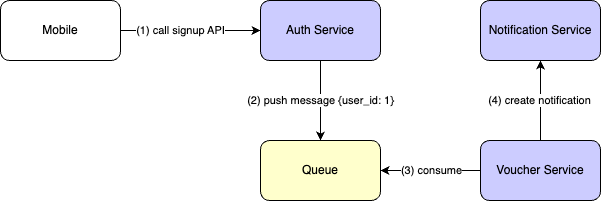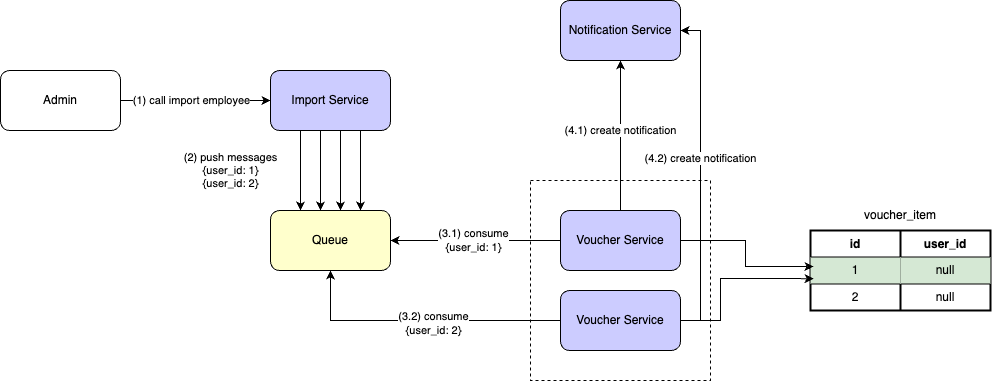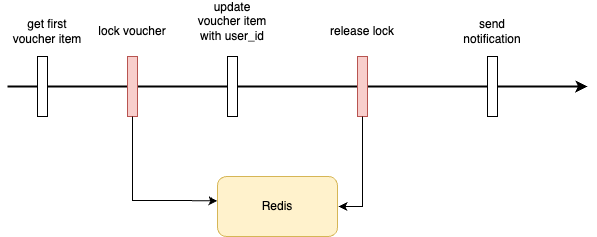My lesson learned with distributed lock
Distributed lock really helps me to solve my issues, but it doesn't mean the issue will be solved immediately if I use distributed lock.
System Overview
Okay. Image that, Im working on the feature that distributes voucher to user. Like, if user signs up, they will receive the voucher item. The flow is simplified as the picture below.

- (1) Mobile calls
signupAPI toAuth Service. - (2)
Auth Servicedoes its stuff then pushes message to queue. The message will be{"user_id": <user_id>}. - (3) The message then will be consumed by
Voucher Serviceto distribute the voucher to user. - (4) Finally, send notification to user to tell that their voucher is ready to use.
So the input is user_id and the output is voucher item distributed to user.
Let's see how Voucher Service distributes voucher item to user. In real world, this service is so complicated that none of us really knows how it works hahaha, but just imagine that we have one table called voucher_item.
voucher_item
| id | user_id | code |
|---|---|---|
| 1 | 1 | BV1LN2KJ |
| 2 | null | ASXKKQRG |
If user_id is not null (eg: 1), it means user 1 already claims voucher item, in this case user 1 has voucher item 1. Otherwise, the voucher is waiting for being claimed.
So when Voucher Service consumes message, it will query the first valid voucher which has {user_id: null} and then updates that voucher with corresponding user_id. Done.

Scenario
I receive my task related to voucher, but it's not about signup. It's about employee import, like, admin will import list of employees into system and then give all of them vouchers. Actually, it's quite the same as the signup feature, but the input now will be array of users instead of one user.
But, as I said, the Voucher Service is too complicated, it's not smart to implement another function to handle that. The easiest way that I come up with is, I will push a bunch of message into queue.
Let's say, admin imports 10 users from 1 to 10, so we will push 10 separate messages into queue to utilize available logic.

Okay, let's keep other steps (3),(4) as now, no need to change anything. We have queue, messages will be handled sequentially. I test that on my local machine and it works perfectly, let's ask QA team to test. Hahaha easy easy.
But then, "Nah, please fix that. It doesn't work on dev env", QA team said.
*dev env is the env that QA uses for testing.
What's wrong here?
Based on QA team's actual result, they test with only 2 employees:
employees
| id |
|---|
| 1 |
| 2 |
user 1doesn't receive voucher, but receives notification.user 2receives voucher, but doesn't receive notification.
Hey hey, are you kidding me? Sounds magic here. But I tested and it worked perfectly on my local machine, right.
Let's see. If user 1 already receives notification, it means, the voucher is already claimed by user 1 (see the logic flow above). But somehow, user 2 claims the voucher of user 1. Then I realize that, the biggest differences between my local machine and dev env is that dev env has 2 pods of Voucher Service (auto scaling). Okay, let's update the diagram.

Much clearer now. 2 messages can be handled almost at the same time, and 2 message handlers can point to the same voucher item.
- 1st message is consumed, it gets
voucher_item 1from database. - 2nd message is consumed right after that, it gets
voucher_item 1database from too since 1st message is still in progress. - 1st message finishes handling, update
voucher_item 1withuser 1. Then send notification touser 1. - 2st message finishes handling, update
voucher_item 1withuser 2. But I'm still not sure whyuser 2doesn't receive notification.
Okay, now our issue is, 2 processes both get access to the same resource. Definitely, distributed lock will save us in this case.
Actually, I intended to implement distributed lock by myself using Redis setnx but then I was recommended using Redlock (opens in a new tab) which works perfectly with multiple Redis nodes.
Let's apply lock into Voucher Service. We can easily find nodejs redlock package (opens in a new tab) and install.
But where should I put the lock? Hmm, it should be placed right after getting voucher item from database, since we can use voucher_item.id as key of redlock.

- 1st message is consumed, it gets
voucher_item 1. It tries to acquire the lockvoucher_item:1and hold it. - 2nd message is consumed, it gets
voucher_item 1. It tries to acquire the lockvoucher_item:1but gets failed since it's being held by 1st. Okay, that's our expected result. We can choose retry message or abort it, it's up to each scenario. - After 1st message finishes, let's release the lock. Sounds good. Commit code and assign to QA team again.
One more time, QA said "Nah sir, the issue is still happening. Please fix that."
What's wrong again?
Is redlock lying me? Nah. Let's see what happens. Since 2 messages can be handled almost at the same time, I come up with this theory.

- 1st message is consumed, it gets
voucher_item 1and hold lock. - 2nd message is consumed, it gets
voucher_item 1right before 1st finishes updatingvoucher_item 1. - 1st finishes handling, it releases the lock.
- 2nd then acquires lock and then updates
voucher_item 1.
Yahhhhhh. Seems reasonable. It's because the process that acquires lock and update voucher item happens too fast.
Okay. let's give it some extra time before releasing the lock and the issue should be solved now.

I change the lock release time from t1 to t2. But you may wonder, what should the gap (t2 - t1) be? I think it should be at least equal to the execution time of logic between acquiring lock and releasing lock. For example, the logic above takes 10ms to acquired lock + update voucher item + release lock, then t2 - t1 should >= 10ms.
Conclusion
That's all I want to share. The lesson learned here is, should choose the lock release time carefully, it will save your life.
Reference
Thank you for reading. Welcome all your comments/feedbacks.